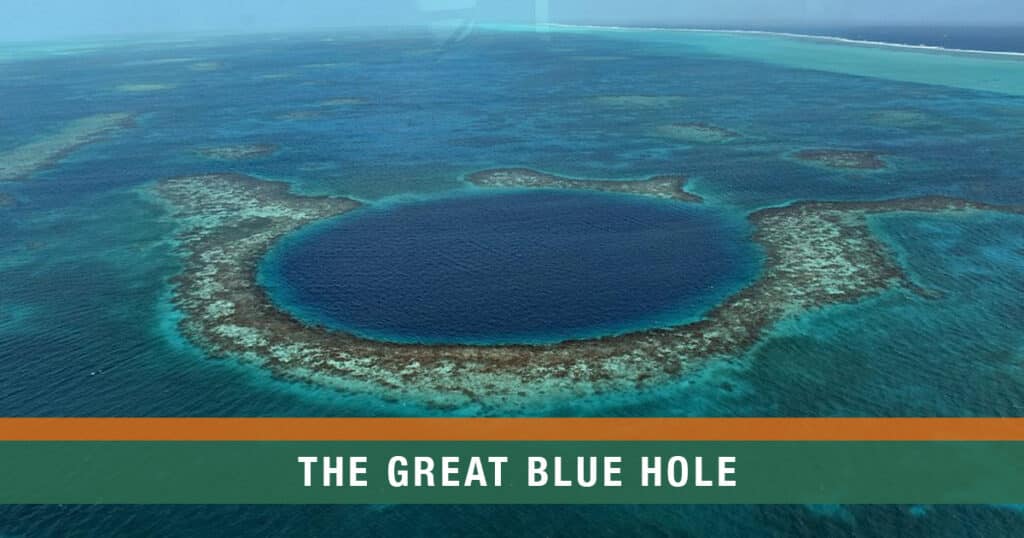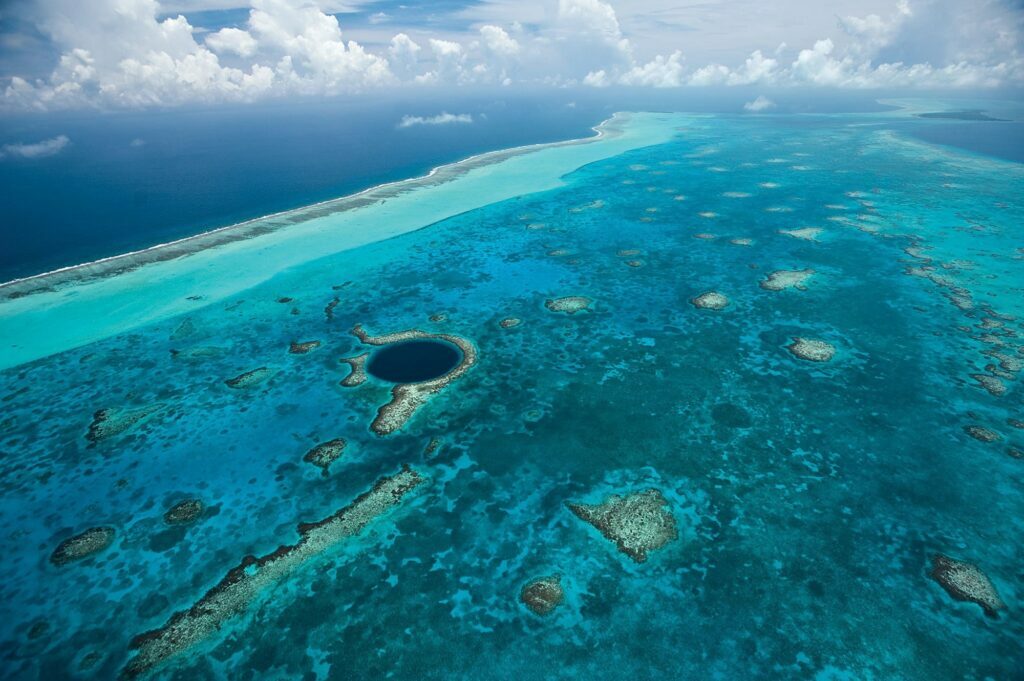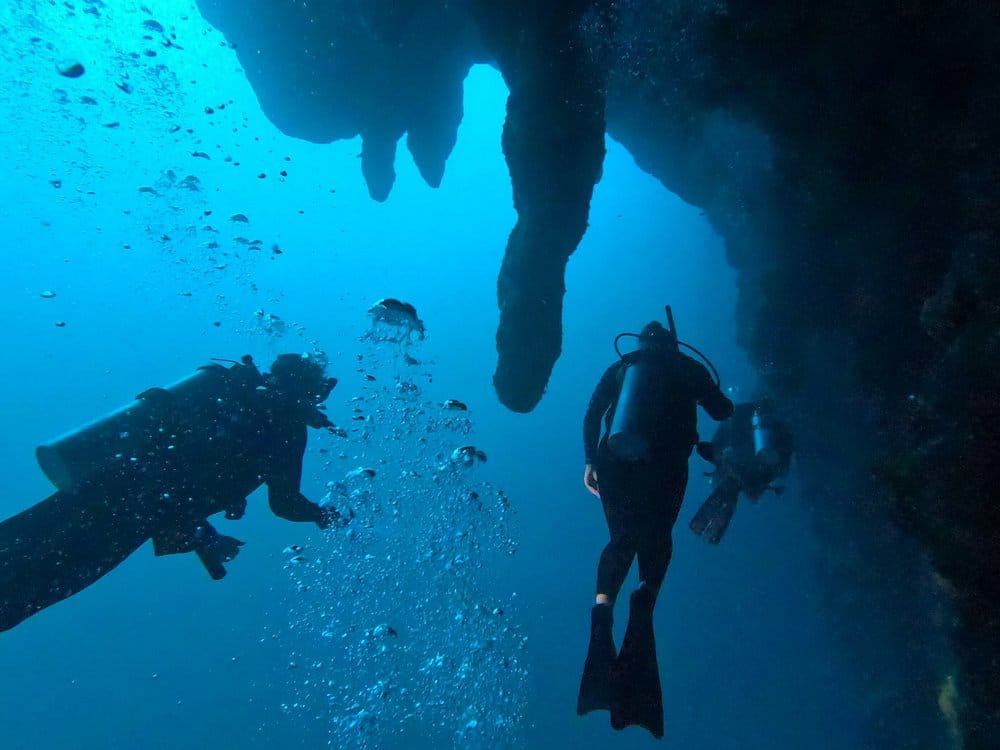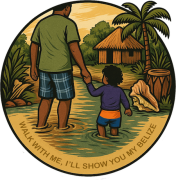🌊 The Blue Hole of Belize: What It Is, How to See It, and Why It Matters
Belize’s Great Blue Hole is one of those places that can’t be understood until you see it with your own eyes.
A perfect dark-blue circle in a sea of turquoise — a sinkhole so deep it feels like time itself dropped anchor here.
But behind its beauty lies story, science, and spirit. The Blue Hole is not just a dive site — it’s a window into Belize’s living geology, and a mirror reflecting our responsibility to protect it.

🌎 Quick Facts About the Great Blue Hole
- Location: Lighthouse Reef Atoll, Belize
- Formation: A collapsed limestone cave system dating back to the last Ice Age (~150,000 years old)
- Depth: Over 400 feet (124 meters)
- Diameter: About 1,000 feet (300 meters)
- UNESCO Status: Part of the Belize Barrier Reef Reserve System, a World Heritage Site
- Access: By boat from San Pedro, Caye Caulker, or Belize City — or by scenic flyover
- Best Time to Visit: March to June (calm seas, clearer skies)
🧭 How the Blue Hole Was Formed
The Blue Hole began as a limestone cave system during the Ice Age.
When sea levels rose, the roof collapsed, leaving behind this circular chasm — one of the largest marine sinkholes in the world.
Stalactites, found deep inside its walls, reveal how the earth itself has shifted and breathed over time.
Beneath the surface, divers descend through layers of light and shadow — from brilliant blue to complete darkness — tracing the planet’s own story of creation and change.
🪸 A Living Part of the Belize Barrier Reef
The Blue Hole sits inside Lighthouse Reef Atoll, one of Belize’s outermost reef systems and part of the second-largest barrier reef in the world.
Around it lies a marine world teeming with life — Caribbean reef sharks, angelfish, and coral gardens that stretch across centuries.
When you visit, you’re not just seeing a hole in the sea; you’re witnessing the beating heart of an ecosystem that connects Belize to the entire Mesoamerican Barrier Reef.
✈️ Ways to Experience the Blue Hole
🛩️ 1. Fly Over It
The flyover is one of Belize’s most iconic sights. Small aircraft depart from Belize City, San Pedro, or Caye Caulker.
You’ll circle the Blue Hole and the surrounding atolls, seeing the full contrast of deep blue against coral shallows.
Flights last about an hour — best in morning light, when the reef glows.
🤿 2. Dive or Snorkel
The Blue Hole is a world-class dive, but not for beginners. It’s a technical descent — narrow entry, limited light, and great depth.
At about 130 feet down, stalactites appear — a ghostly reminder of the cave’s ancient life above sea level.
Most divers stay near the top 40–50 feet, where marine life gathers, while advanced divers explore the deeper limestone formations.
Snorkelers can still experience the outer reef — full of color, coral, and calm shallows.

🐠 3. Stay on Lighthouse Reef Atoll
🌿 Preserving the Blue Hole: Why It Matters (and What You Can Do)
When ocean explorer Fabien Cousteau and Belizean researchers dove the Blue Hole in 2018, they found something sobering —
plastic bottles, coral decline, and silt collecting where life once flourished.
The Blue Hole is a geological wonder, but it’s also fragile.
Climate change, coral disease, and over-visitation threaten the reef that surrounds it. Belize has since expanded marine protection zones, yet the future still depends on how visitors behave today.
You can help preserve it:
- Choose licensed, conservation-minded operators.
- Use reef-safe sunscreen and avoid single-use plastics.
- Respect marine life — never touch coral, feed fish, or collect shells.
- Support Belize’s reef conservation programs, which fund local research and park management.
When you fly or dive here, you’re not just crossing a travel goal off your list — you’re entering a living archive of earth’s history. Treat it that way.
💦 Planning Your Visit
Getting There
- From San Pedro / Caye Caulker: Boat tours depart early (around 5:30 AM) — 2.5 to 3 hours each way.
- From Belize City: Flights by Tropic Air or Maya Island Air offer quick round-trip scenic tours.
- From the Mainland: Combine your visit with inland tours like Xunantunich, Caracol, or the ATM Cave.
Costs & Booking
- Flyover: USD $250–300 per person
- Dive Trip: USD $300–400 per diver (including gear & permits)
- Conservation Fee: USD $40–45 (included in most packages)
Always confirm weather — Lighthouse Reef is an open-sea location and conditions can shift quickly.

🌊 Who You Become in the Blue
You don’t simply visit the Blue Hole — you surrender to it.
The moment you hover above that endless circle, something inside you shifts.
You feel how alive the ocean is, how connected the earth’s layers are, how fragile beauty can be.
You return to land a little quieter.
A little more aware.
You become not a collector of views — but a keeper of memory.
🤍 Walk With Me
If the Blue Hole calls to you — to see it from sky, sea, or spirit — I can help you experience it the right way: responsibly, meaningfully, and with care for Belize’s living reef.
👉 What Is Belize Known For
👉 Reach out to plan your Blue Hole journey
— whether that means flying over it, diving beneath it, or pairing it with inland adventures that reveal the other side of Belize.
Because this isn’t just a place to see.
It’s a reminder of everything worth protecting.
